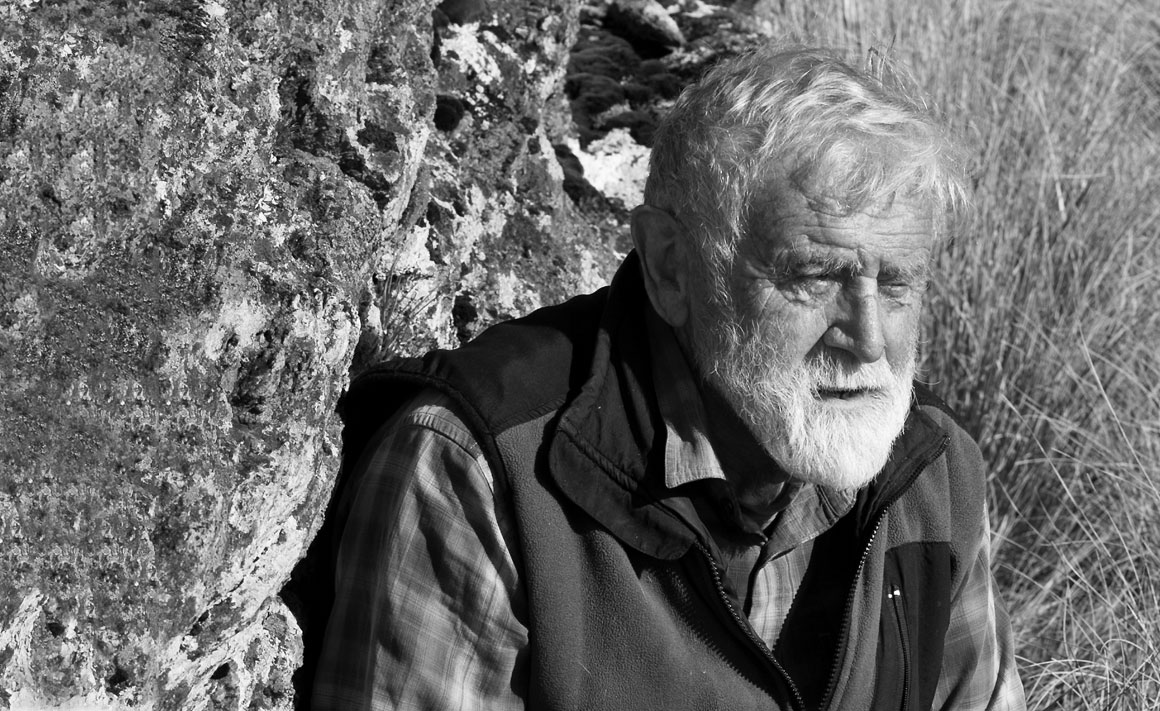 Monday 8 January 2018 11:42am
Monday 8 January 2018 11:42amLong before the importance of nature conservation was a mainstream concern, Emeritus Professor Sir Alan Mark was leading the way.
Over a career spanning more than 50 years, his research has highlighted the significance of tussock grasslands and their management to New Zealand's landscape and ecosystem. He was at the forefront of the Save Manapouri campaign that became a defining event in conservation awareness in this country, and was instrumental in the establishment of the South West New Zealand World Heritage Area: Te Wahipounamu. He has served on numerous boards and agencies, and has been widely recognised for his contribution as a conservation advocate.
Conservation hero
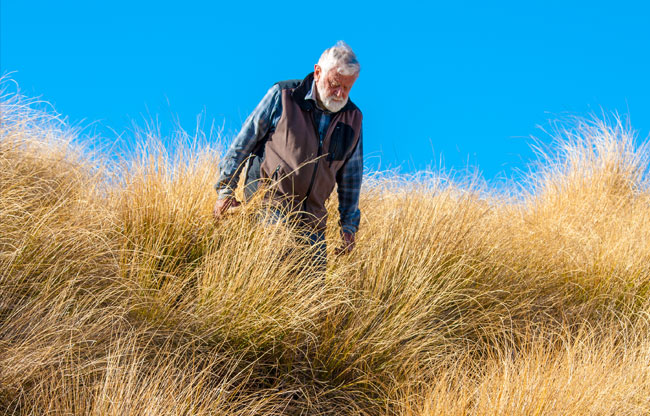
Emeritus Professor Sir Alan Mark: “To tell runholders your mountain tops are where most of the run-off for the lowlands comes from – they weren't happy."
Photo: ©Rod Morris
If there is one person who can give a vivid account of the early days of conservation in New Zealand it is Emeritus Professor Sir Alan Mark (Botany).
Even at the age of 86 his Otago campus office remains a base for fighting conservation battles, tackling the current ecological issues that show all is still not well with the country's environmental management.
Today his name is inextricably tied to the successful Save Manapouri campaign and the conservation of New Zealand's stunning high country. Over the years he has also served on many boards and committees to establish new reserves and national parks.
"Manapouri was a good example of compromise – the integration of nature conservation values with their hydro potential. I think it was the forerunner for sustainable use of natural resources, which later came through in the Resource Management Act."
Born in Dunedin, Sir Alan credits his parents for his interest in the outdoors.
"My father was an electrician, but he aspired for me to be a farmer, so I went to Mosgiel District High School every day from Dunedin and did their agriculture and horticulture courses," he says.
"My folks didn't have the cash for me to go to Lincoln so I came here to Otago in 1950 and did a bachelor's degree majoring in botany and zoology."
Master's research into the ecology of the Maungatuas effectively launched his lifelong interest in the high country. Then, following a Fulbright travel grant to Duke University in North Carolina, Sir Alan returned to Dunedin in 1959 to work for the Otago Catchment Board, researching the degradation of the high country tussock grasslands.
It turned out to be survey work rather than proper research to understand the problem. Dissatisfied, Sir Alan lined up a job in Canberra with ANU, but Botany Professor Geoffrey Baylis countered with a research role for the Hellaby Indigenous Grasslands Research Trust, looking at the basis for high country degradation and how to manage it sustainably.
He was also offered a lectureship, beginning a 50-plus year working association with Otago, especially impressive given the University is only now in its 150th year.
There was a pervading belief that upland snow tussock grassland was out of phase with the environment, but Sir Alan soon realised the problem was its management. Tussocks could cope with burning, but could not handle severe grazing while recovering.
"There is fresh green foliage and the plant is pumping nutrients into these new leaves, making them more palatable and nutritious. Grazing could kill a tussock that's potentially immortal, in just one year," he says.
His contentious conclusions undercut traditional practices and attracted flack – the Vice-Chancellor fielding highly critical letters from some concerned runholders. It wouldn't be the last time.
Sir Alan and his students also established how well tall snow tussocks were adapted for maximising water yield and soil conservation.
"We found they're very efficient at trapping fog: each tussock can pick up half a litre an hour, even when there's no measurable rainfall. To tell runholders your mountain tops are where most of the run-off for the lowlands comes from – they weren't happy."
The government eventually agreed the high country had great importance for water and soil conservation, as well as biodiversity, landscape and recreational values.
A tenure review programme was introduced, allowing runholders to freehold the more productive lowlands and relinquish upper areas into DOC management. Since the mid-90s almost a million hectares of the 2.6 million hectares of high country land has been added.
Sir Alan's high profile involvement with Manapouri began in 1969 when the Electricity Department contracted the University to do a lakeshore study in preparation for raising the lake level to generate more power for the Bluff aluminium smelter.
"It became politically contentious because our results showed that the lakeshore was both highly vulnerable and diverse biologically, and that raising the lake would only produce another 4.3 per cent of electricity annually, which wasn't critical for the smelter."
Although the government of the day pushed ahead, the Norman Kirk-led Labour landslide in the 1972 election stopped the proposal dead.
Kirk also asked Sir Alan to chair a group called the Guardians of Lakes Manapouri and Te Anau, largely made up of local campaigners, to advise on lake management and ensure there was no damage to lakeshores – a role he held for 26 years.
"Manapouri was a good example of compromise – the integration of nature conservation values with their hydro potential. I think it was the forerunner for sustainable use of natural resources, which later came through in the Resource Management Act."
Sir Alan hesitates to call it the beginning of New Zealand conservation, giving the nod to the work done to save Waipoua Forest in the 1950s. He does, however, draw satisfaction from the increased public interest in conservation since the Save Manapouri campaign.
Other battles followed. During his four terms as an elected member of the Otago Catchment Board they lost the fight to stop the Clyde Dam, although later plans for further dams were stymied.
Working with Forest & Bird during his term as national president (1986-90) he played a major role in securing the prestigious 2.6 million hectare South West New Zealand World Heritage Area: Te Wahipounamu, covering about 10 per cent of the country's land area.
In his 1998 paper in the Royal Society Journal (Vol. 28: 657-84), Sir Alan describes it as an area of outstanding universal value: one of the great natural areas of the world. "It embraces four national parks and is the largest and least modified area of New Zealand's natural ecosystems."
As a National Parks and Reserves Authority member he helped prevent logging of the unique 45,000ha Waitutu Forest in western Southland, which has since been added to the World Heritage Area.
All these efforts did not go unrecognised. Sir Alan was elected a Fellow of the Royal Society of New Zealand in 1978, was knighted in 2009 for his achievements in science-based conservation, and awarded an Honorary Doctor of Science degree by Otago in 2012. He was also awarded life membership of the New Zealand Ecological Society, the Ecological Society of America and the Forest and Bird Protection Society.
For Sir Alan the battles continue.
"We had a rough spell with National who were hell-bent on economic development at any cost: we lost the battle for the unique Denniston Plateau. But the present coalition government is a breath of fresh air in terms of addressing the environment, particularly climate change."
The latest initiative is the Wise Response Society – launched in 2013 with Sir Alan as the chair and Sir Geoffrey Palmer as patron – to lobby for a sustainable future for the country.
They have five platforms around global warming and climate disruption, ecological and environmental security, human well-being, economic security and business continuity.
"We've got quite an informed group, representing a wide range of expertise and we've made several comprehensive submissions, some successful."
These include issues such as the Child Poverty Reduction Bill, the Tax Working Group, the Productivity Commission and the Emissions Trading Scheme.
"Currently we're supporting the Zero Carbon Bill and assessing the contentious issue of whether the short-term gases like methane are treated differently to the long-term gases like nitrous oxide and carbon dioxide."
Sir Alan says Sir Peter Gluckman's final report as the Prime Minister's Chief Science Advisor said methane needs to be treated the same, particularly when 48 per cent of our emissions are from agriculture with methane the major component.
"Methane is very potent for the 20-odd years it is around."
It is yet another major issue for Sir Alan to tackle – not the way most would spend their retirement.
"You're a long time dead, so surely you address the welfare of future generations."
Today
The University of Otago fosters environmental and conservation research across many academic disciplines.
1
Tipping the balance
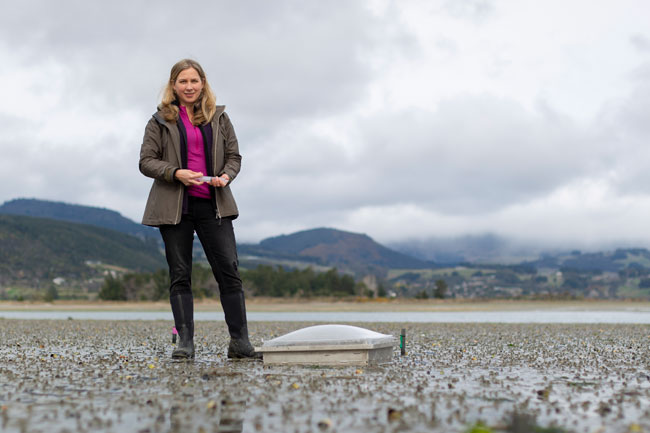
Dr Candida Savage: "We are principally interested in the two main land-based stressors for New Zealand's estuarine and coastal systems – nutrient run-off and sediment input."
Recognising the threat of sudden degradation in New Zealand estuaries should become easier thanks to the involvement of University of Otago researchers in the National Science Challenge Tipping Points project.
Dr Candida Savage (Marine Science) says Tipping Points is one project within the Sustainable Seas programme, established to enhance the value of New Zealand's marine resources, while providing a healthy marine environment for the future.
"Estuarine systems can pass thresholds or tipping points quite rapidly from multiple stressors, diminishing the goods (for example, providing kai moana) and services (including nutrient cycling) we derive from these systems. Trying to get back to a healthy state takes much more effort and cost than just preventing it from happening in the first place.
“We want to give coastal managers the tools to recognise when their system is at high risk and approaching a tipping point, so they can prevent this from happening."
“The Tipping Points team is focusing on inter-tidal sandflats as these habitats are prevalent in New Zealand and crucially important. We want to give coastal managers the tools to recognise when their system is at high risk and approaching a tipping point, so they can prevent this from happening."
Tipping Points is running experiments and collating data from 24 sites across 15 estuaries, ranging from Northland to Southland, encompassing a gradient of healthy to stressed sites. Savage's Otago team is investigating six sites in Otago and Southland.
“Sites include Blueskin Bay near Dunedin, as well as Jacobs River estuary near Riverton and New River estuary near Invercargill: the latter two estuaries have high background nutrient concentrations. Then we've got two sites in the Catlins which are more pristine systems, but have historically been deforested.
"We are principally interested in the two main land-based stressors for New Zealand's estuarine and coastal systems – nutrient run-off and sediment input."
While much is known about the effects of nutrients alone, or the effects of sediments alone, little is known about how these two stressors interact.
"Sediments can smother shellfish and reduce their ability to filter-feed efficiently, but we don't know how that interacts with nutrients," says Savage.
"We know that nutrients can lead to blooms of nuisance macroalgae in estuaries, which can alter the oxygen conditions in the sediment and negatively impact benthic communities.
“By measuring a range of ecosystem processes and functions like production and nutrient cycling in benthic chambers, we can assess how these systems are coping with multiple stressors. In addition, by taking samples to analyse key components of the biological community and the associated physical and chemical setting, we can better understand how biodiversity may influence these ecosystem processes."
Savage says all sites have established populations of large wedge shells (Macomona lilliana), a deep-dwelling bivalve that plays an important role in nutrient cycling. "People have done research on what role this species plays in the ecosystem. We know how it influences production and nutrient cycling and some of the feedbacks on other species."
The research ultimately aims to provide information towards ecosystem-based management, which recognises interactions between humans and the marine environment.
Funding
Sustainable Seas National Science Challenge
Environment Southland
2
Glacial evolution
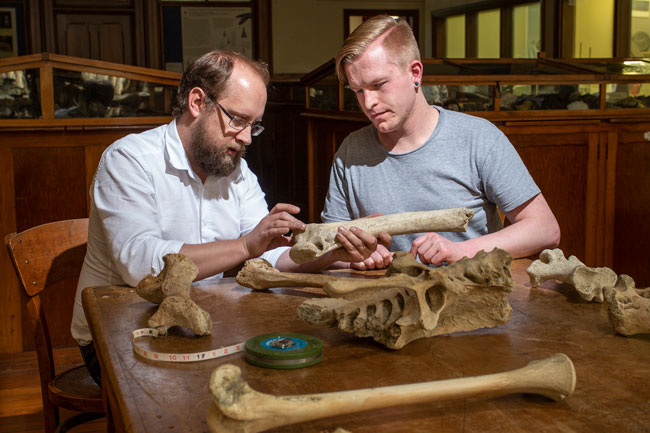
Dr Nic Rawlence and Alex Verry: Their research focuses on the effects of the last glacial period on the distribution of bird and plant species in New Zealand's Southern Alps.
Dr Nic Rawlence (Zoology) heads a research project that is exploring whether glaciers drive biodiversity.
Rawlence, who is a director of the Otago Palaeogenetics Laboratory, explains that the research focuses on the effects of the last glacial period on the distribution of bird and plant species in New Zealand's Southern Alps.
Rawlence and PhD student Alex Verry are working with ancient DNA extracted from fossil bones from birds such as moa, takahē and rock wren; and from organic material from plants such as beech trees preserved in sediments.
The evidence they are gathering points to glaciation causing animals and plants to retreat to favourable isolated refuges, where genetic mutations and other factors over thousands of years and through many glacial cycles caused new species or lineages to emerge.
Rawlence says that they are gathering the fossil bones from swamps, caves and samples from museum collections, and the organic material from core samples they and others are drilling in key locations such as Okarito on the West Coast.
He says that ancient DNA technology, along with a combination of other tools such as radiocarbon-dating, is enabling them to discover changes in family history and geographical distribution at precisely dated times from the last glacial period between 19,000 and 29,000 years ago to today.
Rawlence points out that massive ice sheets during the last Ice Age have traditionally been seen as causing great damage to ecosystems, with previous genetic studies indicating reduced biodiversity in many glacial regions of the world, notably in Europe and North America.
He says, however, that evidence from mountain ranges in temperate regions such as the Southern Alps suggests the opposite.
He explains that the evidence they are gathering points to glaciation causing animals and plants to retreat to favourable isolated refuges, where genetic mutations and other factors over thousands of years and through many glacial cycles caused new species or lineages to emerge.
Verry notes that, as well as the Southern Alps ice cap causing animals and plants to retreat north and south, West Coast glaciers moved down the mountains like fingers, isolating separate populations of the same species within a comparatively small area on either side of a glacier.
The pair cite as an example of this glacial-driven biodiversity the evolution of northern and southern lineages of rock wren.
Rawlence says that the findings related to birds are being reinforced by complementary research by another PhD student, Luke Easton, on New Zealand frogs; and by a master's student, Lachie Scarsbrook, on geckos.
Rawlence says that similar findings would also be likely from mountain ranges in other temperate regions such as the Andes, Himalayas and Pyrenees.
He similarly believes that volcanic activity in the North Island such as the Taupo eruption would also have contributed to biodiversity by isolating populations of animals and plants.
Rawlence adds that the research highlights the value of natural history collections in museums and the danger of not valuing them and their curators.
Funding
Marsden Fund
University of Otago
3
Modelling melt
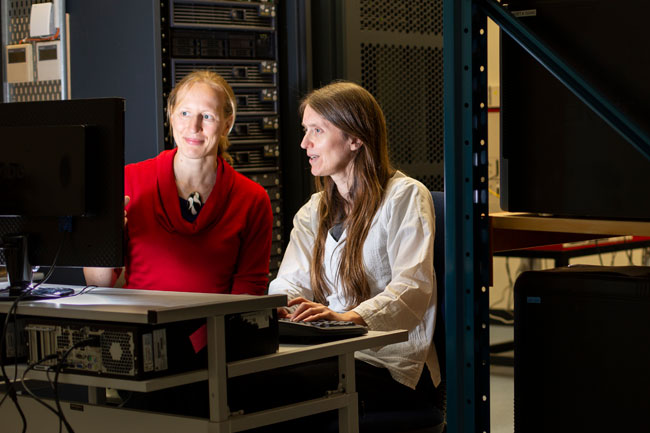
Dr Shona Mackie and Dr Inga Smith: “Everyone agrees a warmer climate means we can expect Antarctic sea ice to shrink … With improved models, putting a time frame on those expected changes will be possible.”
Creating an Earth system model that accurately represents processes in the Antarctic has the potential to provide valuable data for predicting future New Zealand weather patterns.
Project leader Dr Inga Smith (Physics) says New Zealand weather patterns – including cyclones, increased rainfall and abnormal temperatures – could be influenced by changes in Antarctic sea ice. The project, investigating the impacts of fresh water from icebergs and ice shelf melt, is part of a wider New Zealand Earth System Modelling and Prediction (NZESM) programme through the Deep South National Science Challenge.
"New Zealand, and the University of Otago in particular, has internationally recognised expertise in observational sea-ice science,” Smith says. “The Arctic sea ice has been shrinking in extent and thickness, but that's not the case around Antarctica where it's not as obvious exactly what's happening."
“Fresh water can do strange things when it mixes with salt water, and when ice shelves melt or break up the lost mass ends up in the ocean.”
Project research fellow Dr Shona Mackie says Earth system models are the next generation of climate models and include aspects like biology and biogeochemistry.
However, the Southern Ocean has not been well represented in models to date, so it has been decided that better modelling is needed to accurately capture and predict processes, especially for Antarctic sea ice which behaves very differently to that of the Arctic. This is despite sea ice in both places being composed of frozen sea water which moves with the wind and ocean currents and reflects sunshine, Mackie explains.
"The Antarctic has a landmass surrounded by ocean, whereas the Arctic is ocean surrounded by a land mass. How the sea ice behaves is very different because of these different environments."
Smith says it made sense to tap into New Zealand's long history and extensive expertise and data in Antarctic observational sea-ice science to create a better model.
Rather than starting from scratch, they are developing and investigating an existing model, finding the processes that are important to the Southern Ocean and Antarctica that are not well represented.
"Antarctic sea-ice extent was increasing overall up until about two years ago, so it's quite different to the Arctic, but nobody really knows why," says Smith.
"Maybe it's the wind, maybe it's fresh water from icebergs and ice shelves, which is what we're looking at. Maybe it's just natural variability.
"However, everyone agrees a warmer climate means we can expect Antarctic sea ice to shrink like it has in the Arctic over the longer term. With improved models, putting a time frame on those expected changes will be possible.”
Otago researchers already have extensive data about the interactions between frozen seawater and ice shelves made up of fresh-water ice pushed down from glaciers.
"If we are going to make decisions about the future based on these models then we need to understand what they do and don't do well, then see what we can improve," says Mackie.
"One of the things none of the models capture accurately is melt water from ice shelves. Fresh water can do strange things when it mixes with salt water, and when ice shelves melt or break up the lost mass ends up in the ocean.
"Almost all the models represent mass loss as a constant process but, in reality, that flux is changing – and the change is likely to be different in different parts of Antarctica. Our research tries to work out the impact of the change on climate and sea ice, and so determines the significance of it being left out of the models."
All this research requires a powerful supercomputer and these resources are currently being developed in New Zealand. Fortunately, international collaboration with Dr Jeff Ridley (UK Met Office) has allowed access to specialised research computers, including the MONSooN system – a collaborative facility supplied under the Joint Weather and Climate Research Programme, a strategic partnership between the United Kingdom Met Office and the Natural Environment Research Council.
They also work closely with Professor David Stevens (University of East Anglia) and Professor Cecilia Bitz (University of Washington).
Funding
Deep South National Science Challenge
4
Accounting for biodiversity
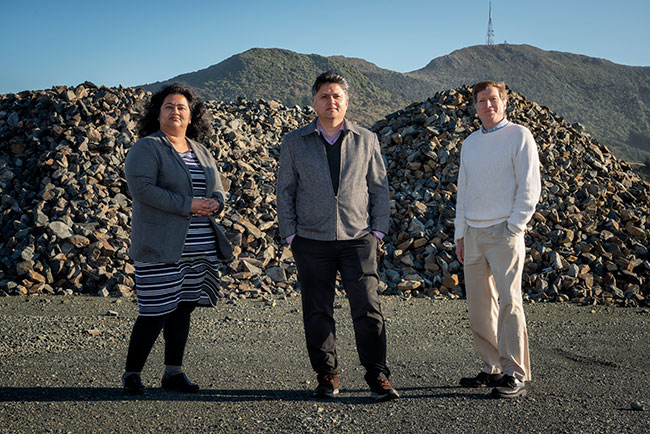
Dr Mansi Mansi, Dr Rakesh Pandey and Professor Ralph Adler: Their research is clear: more information is needed from companies for their biodiversity performance to be adequately externally assessed.
Biodiversity accounting has become part of the annual reporting cycle for a growing number of companies, but why is this now important and what does this mean for New Zealand business?
Biodiversity accounting is a way of recognising and quantifying the environmental impact of an organisation's operations. Some global companies now undertake annual biodiversity accounting, recognising the importance of understanding the true costs of business.
The University of Otago Business School is leading New Zealand research into understanding how companies are accounting for their use of natural resources.
"There is definitely awareness amongst big business for the need of social licence to operate, which is why biodiversity accounting is becoming so important.”
Accountancy and Finance researchers Professor Ralph Adler, Dr Rakesh Pandey and Dr Mansi Mansi have studied biodiversity disclosure from large mining companies in Australia, and also a longitudinal study of the top 150 global companies.
Heavy industry was amongst the first to adopt biodiversity accounting – those considered to have a larger environmental footprint, like mining or chemical corporations. Now most of the top 150 global companies disclose some biodiversity information – and biodiversity accounting has become a new area of research.
However, although the larger companies have significantly increased their disclosures on biodiversity, the research shows only 15 of them are providing any substantial reporting. There was variable reporting, with a lack of consistency across all index items, even among the high-scoring companies.
Many interviewees claim their companies are more open and transparent, but the researchers found the public reports had often partial and incomplete environmental reporting, and some companies collected and used performance data internally, but failed to report it in public. Sincerity of corporate environmental reporting can be an issue, they found.
The research is clear: more information is needed from companies for their biodiversity performance to be adequately externally assessed.
Pandey notes the growing power of stakeholders in requiring more of their company – in disclosure and in environmentally sustainable behaviour across every aspect including waste, pollution, carbon emission and climate change activities.
He believes regular and detailed reporting of biodiversity information to a company's stakeholders should be viewed as a tool to gain stakeholders' trust and support.
"There is definitely awareness amongst big business for the need of social licence to operate, which is why biodiversity accounting is becoming so important.”
Paying attention to biodiversity and ecosystem health allows companies to recognise risks and opportunities, anticipate new markets, mitigate their impacts, improve stakeholder engagement and demonstrate leadership.
The researchers say that this applies to all companies, not just the leaders: it's easy to think that companies like mines are the ones that need to be answerable, but all organisations have an environmental footprint and need to be responsible for their product or service. They add that companies not only need to adequately measure the environmental effect of their own business, but also the impact of their suppliers and financiers.
That has implications for all New Zealand business. The smart companies are the ones that understand the changing world, have a good understanding of how their practices interact with the natural environment and are coming up with strategies.
The researchers conclude that it's only a matter of time before the current financial accounting standards are extended to account for the costs associated with biodiversity degradation that arise from business activities. Will New Zealand be ready?
Funding
University of Otago